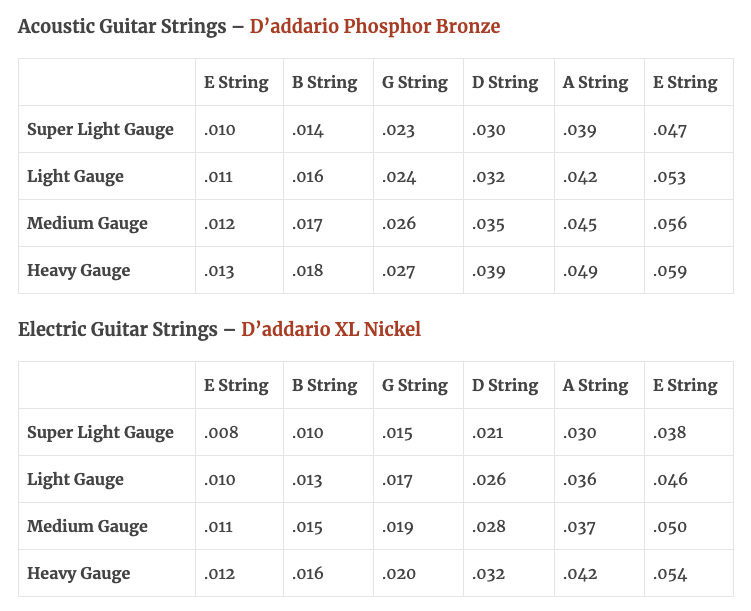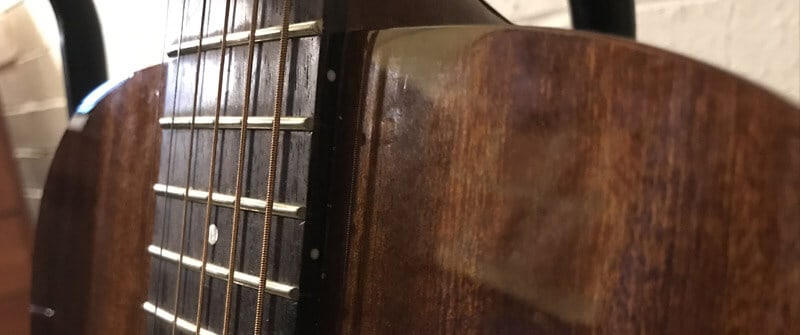Considering your first guitar? Heard you should start on the acoustic but you’re wondering if acoustic guitars are harder to play?
Acoustic guitars are considered harder to play than electric guitars as the strings are usually a heavier gauge. The action (string height) is also usually higher. The higher action and greater tension make the process of fretting notes more difficult than on an electric guitar.
A LOT of people ask the same thing before buying their first guitar. In today’s article, we’re going to give our reasons why the acoustic guitar is harder to play than the electric, at least for beginners, but also why that shouldn’t necessarily put you off starting on the acoustic.
Why are acoustic guitars harder to play?
If you are a beginner, there’s really no question that the acoustic is more difficult to play. This is almost entirely due to the strings being harder to push down against the fretboard, along with less obvious reasons such as the smaller body size of the electric guitar being more comfortable, the neck narrower, and the body shape providing easier access to the upper frets.
When you are new to playing guitar, and learning the basics e.g. basic scales (major, minor, pentatonic) and open chords the fretting of notes (e.g. pushing the strings against the fretboard) requires hand strength and the skin at the fingertips to harden which can take time.
This is why many beginners often complain when learning guitar that their fingers and hands are sore and they cannot play for long periods.
As electric guitars utilize a lower action (string height) and use lighter gauge strings (there are exceptions) the level of discomfort beginners experience on the electric guitar is less compared to the acoustic.
But, that’s really only the case for beginners, who happen to be learning the basics.
If you are a more experienced guitarist transitioning from the electric to the acoustic, or vice versa, it’s almost impossible to say which is the more difficult to play.
After all, how can one compare percussive fingerstyle on the acoustic to playing exotic solos on the electric? Both take enormous skill and perseverance. It’s akin to comparing apples to oranges, or Steve Vai to Chet Atkins.
So while it’s fair to say the acoustic is more physically demanding for beginners, it’s not necessarily the case that the acoustic guitar is more difficult than the electric guitar overall.
It depends on what you want to do with the guitar.
For example, the electric guitar might appear easier to play fast due to the lower action and lesser string tension, but the acoustic with its wider neck and therefore wider string spacing is considered easier to play fingerstyle and form clean open chords.
It’s also true that string noise e.g. noise emanating from other strings not being intentionally played is increased on the electric guitar due to amplification, whereas on the acoustic guitar, this is generally less of a problem.
String tension and action: acoustic V electric guitar
I’ve mentioned string tension and action above, as the primary reason the acoustic guitar is harder to play than the electric, but you might be wondering why. Why does the acoustic guitar have greater tension on the neck and strings and why is the action higher?
Heavier Gauge Strings
The standard medium string gauge for the acoustic guitar is .012 – .056″.
Guitar strings are measured as 1/1000 of an inch, the lightest string, the high E string, is 0.012 inches, while the heavier low E (6th string) is 0.056 inches.
Medium gauge strings for the electric however are .011 to 0.050. While there is less disparity on the higher strings (light strings can only be so thin before they are more prone to breaking) the real difference comes when observing the bass strings e.g. the D, A, and low E strings which are quite a bit lighter than their acoustic counterparts.

The reason acoustic guitars use heavier gauge strings is simple. Heavier gauge strings project more volume due to their greater mass. This is important on an acoustic instrument as the vibrations from the strings are transferred to the body of the guitar and soundboard to produce sound.
Alternatively, the electric guitar mostly relies on the pickups and the amplifier to project sound. Therefore, string gauge isn’t a deciding factor when considering volume, just playability.
Higher Action

As the acoustic guitar usually has much thicker bass strings the action must also be higher to prevent the strings from vibrating against the fret wires, causing fret buzz.
Fret buzz while a common issue on both the electric and acoustic guitar is often more evident on the electric if you are transitioning from the acoustic as the electric guitar requires a lighter touch and can take some time to adjust to if you are predominantly an acoustic guitarist.
Acoustic guitar strings due to their additional mass when played at the same level of intensity as lighter gauge strings sound louder. When transitioning from the electric to the acoustic and played at the same volume less energy needs to be imparted on the strings, also reducing the potential for fret buzz.
Fret buzz is caused by either a neck that does not have sufficient relief e.g. it does not bow inward enough for the strings to have adequate clearance of the fret wires, or the action is too low across the neck. Neck relief is adjusted using the truss rod on both acoustic and electric guitars.
If the action is too low on an electric guitar this can be fixed by adjusting the individual saddles or adjusting the height of the entire bridge itself.
If the action is too low on an acoustic guitar however this is often more difficult to fix. In most cases, if the fret buzz is occurring at the first fret only the nut may need replacing. If the buzz is occurring further up the neck the saddle will need to be replaced with a taller saddle or the neck relief adjusted.
A good rule of thumb is to check your action at the 14th fret. This is typically where the neck joins the body on most standard acoustic guitars, except parlor and 12-fret guitars. A string height of 3/32” at the low E string and 2/32” at the high E string should prevent fret buzz from occurring but this is also dependent on the amount of relief the neck has.
Wound G String
One last notable difference between acoustic and electric guitars is the wound G string. On the acoustic guitar the G, D, A, and low E strings are usually wound. On the electric guitar, the G string is often unwound, which makes the string much easier to bend, whereas on the acoustic guitar, the additional mass will help the string project more volume.
What should you start on when learning? Acoustic or Electric?
When I first started playing guitar, all the advice at the time was to start on the acoustic and develop hand strength and dexterity due to the heavier strings, before moving over to the electric. Mind you, I was also advised not to play left-handed, despite being left-handed.
Much of this is nonsense, and for the most part, is rarely considered the right approach anymore.
Most guitarists and guitar teachers I’ve heard speak about this specifically now acknowledge that you should learn on the instrument you are most interested in, whether it be acoustic or electric guitar as this is likely to be the most interesting to you and as a result, you are more likely to continue learning well past the initial excitement phase.
Having said that, there are still some fairly solid reasons to start on the acoustic, including:
- You don’t need additional equipment
- Due to requiring less equipment (amps, leads), it’s a more portable instrument
- Acoustic guitars are typically more budget-friendly
The first point (not needing additional equipment) is far more important than many people realize for a very simple reason – If you don’t practice you won’t improve. If you don’t improve you won’t stick at the guitar, and eventually, you will put the guitar down and perhaps never pick it up again.
By simply taking away that one obstacle e.g. needing to plug in a cable and play through an amp and possibly incorporate effects pedals, in my experience, it becomes far more likely that the student will practice on the acoustic more often. Especially if it is kept handy, as the student just needs to pick up the guitar, and they are up and running.
But even taking this into account, the acoustic guitar won’t be the best choice for everyone.
What if the reason you have a hankering for learning the guitar is that you have been inspired by the electric guitar?
I know myself, I wanted a guitar almost the minute I first heard Joe Satriani’s ‘Always with Me, Always with You. It was years later that I transitioned to becoming mostly an acoustic player.
What if I started solely on acoustic and hated it? I wonder if I’d even be playing now. Would I have even made it past a few short weeks before deciding that the guitar wasn’t the right instrument for me?
What about kids?
I’ve taught two of my children guitar and I started both of them off on classical guitar before transitioning to the steel-string acoustic guitar and then also onto the electric. While this comes down to personal preference it always surprises me that the humble classical guitar is not included more often as a potential option when people decide which guitar they want to start on.
The classical guitar has been around considerably longer than both the electric and acoustic guitar and due to being played with nylon strings requires a lighter touch and is far more forgiving on the hands and fingers as the softer strings require less effort to push down and don’t hurt the fingertips as much as steel.
This is an important consideration for children, as most kids complain of sore fingertips and hands when they first start playing guitar and are a long way off forming calluses that reduce the discomfort this may cause.
The classical guitar is far more budget-friendly also which is another important consideration when buying instruments for children who you really have no idea if they still stick with. There are a number of classical guitar starter packs available for children who are learning the guitar.
I would, however, consider build quality and avoid the least expensive options. Many of the cheaper starter kits are of questionable quality and this can be a turn-off for kids learning guitar who might wonder why the guitar rattles and buzzes when they play never stays in tune or just sounds bad.
It’s also true that many cheaper classical guitars (and many classical guitars in general) do not feature a truss rod, so once the neck has some bow to it, it is going to stay that way and become more difficult to play.
Final Thoughts
So, are acoustic guitars more challenging than electric guitars to play? there’s little doubt, from a mechanical perspective that the acoustic guitar is a more challenging instrument, but this should not be your sole consideration when choosing an instrument to begin learning guitar on. Keep in mind the music that has inspired you to want to play the guitar in the first place is what is most likely to keep you going when the going gets tough and frustrating, as it does for everyone when learning guitar. But, if you really can’t make up your mind, go with an acoustic guitar, in my opinion, they are the finest instruments on the planet, but then again, perhaps I’m just a touch biased 🙂




